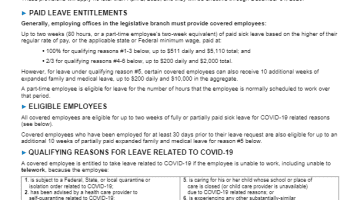The Families First Coronavirus Response Act (FFCRA or Act) requires employing offices in the Legislative Branch of the Federal government to provide covered employees, as defined in the Congressional Accountability Act, with paid sick leave and, for certain covered employees, expanded family and medical leave for specified reasons related to COVID-19. These provisions will apply no later than April 2, 2020, and they will be effective through December 31, 2020.
PAID LEAVE ENTITLEMENTS
Generally, employing offices in the legislative branch must provide covered employees:
Up to two weeks (80 hours, or a part-time employee’s two-week equivalent) of paid sick leave based on the higher of their regular rate of pay, or the applicable state or Federal minimum wage, paid at:
- 100% for qualifying reasons #1-3 below, up to $511 daily and $5,110 total; and
- 2/3 for qualifying reasons #4-6 below, up to $200 daily and $2,000 total.
However, for leave under qualifying reason #5, certain covered employees can also receive 10 additional weeks of expanded family and medical leave, up to $200 daily and $10,000 in the aggregate.
A part-time employee is eligible for leave for the number of hours that the employee is normally scheduled to work over that period.
ELIGIBLE EMPLOYEES
All covered employees are eligible for up to two weeks of fully or partially paid sick leave for COVID-19 related reasons (see below).
Covered employees who have been employed for at least 30 days prior to their leave request are also eligible for up to an additional 10 weeks of partially paid expanded family and medical leave for reason #5 below.
QUALIFYING REASONS FOR LEAVE RELATED TO COVID-19
A covered employee is entitled to take leave related to COVID-19 if the employee is unable to work, including unable to telework, because of the employee:
- is subject to a Federal, State, or local quarantine or isolation order related to COVID-19;
- has been advised by a health care provider to self-quarantine related to COVID-19;
- is experiencing COVID-19 symptoms and is seeking a medical diagnosis;
- is caring for an individual subject to an order described in (1) or self-quarantine as described in (2);
- is caring for his or her child whose school or place of care is closed (or child care provider is unavailable) due to COVID-19 related reasons; or
- is experiencing any other substantially-similar condition specified by the U.S. Department of Health and Human Services.
